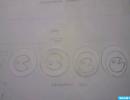Paper modules, diagrams, sizes. Modular paper origami: how to make a triangular module. Illustrative examples: “Herringbone”
The creation of three-dimensional figures from triangular modules, the so-called 3D origami, was invented in China. The whole figure is assembled from a huge number of identical parts (modules). Each module is folded according to the rules of classic origami from one sheet of paper, and then the modules are connected by inserting them into each other. The friction force that appears in this case prevents the structure from falling apart. Therefore, such models are assembled without glue.
You can experiment with different types paper. Suitable office paper different colors, coated colored paper. Sometimes such figures are made from magazine clippings and candy wrappers. School colored paper is not suitable because it is too thin, friable, breaks and tears at the folds.
Cut a sheet of A4 paper into approximately 16 pieces (4 pieces wide and 4 pieces long). You can do this: fold the sheet in half into a booklet and fold this half in half again. We turn the long side towards us and again fold it into a booklet in half and then in half again. Let's expand. Cut along the resulting lines.
These will be blanks for the corners. I will make a reservation that the dimensions of the blanks for triangular modules depend on the size of the craft.
Fold the corners as shown in the photo:








With my own hands. The two-color palette gives interesting combination. This unusual craft, which can be made from paper of all colors.
Necessary parts for creation:
- Paper triangles for origami purple and white;
- Glue gel or glue gun.
Stages of work:
We start the assembly with purple triplets, which we place as illustrated in the photo:In total you need to make 14 triplets. We close the blanks in a circle. We assemble two more circular rows of purple triangles with 28 parts in each row. The result is the following:

4 rub. – assembly is carried out using white triangles. In the current row, you need to increase the number of modules to 35. To do this, for every fourth origami triangle from the previous row, you need to string not 1, but 2 elements at once

5 rub. – 35 purple triangles;
6r. – alternating elements according to the scheme: 1 white origami triangle, 4 purple

7r. – in this row you need to increase the number of component elements to 42. To do this, perform the assembly as follows:
We string 2 white paper triangles onto a white element of the previous row, then 1 purple, then 2 purple ones onto one triangle of the previous row.

and again purple, we dress as usual.
Next, repeat the combination until the end of the row.
8 rub. – alternation of elements: 3 white, 3 purple modules;

9r. – alternation: 4 white, 2 purple elements;

10 rub. – alternation: insert 1 white triangle between two purple ones of the previous row, then – 1 purple, 3 white, 1 purple;
11r. – alternation of elements according to the scheme: 1 purple, 2 white;

12 rub. – alternation: insert 1 purple origami triangle between the two white ones of the previous row, then 1 white one;


13r. – alternation of elements: 2 purple, 1 white;

14 rub. – alternation: 1 purple, 1 white, 3 purple, 1 white;

15 rub. – alternation: 2 white, 4 purple triangles;

16 rub. – alternation: 1 white, 5 purple;

17r. – 42 components of violet color;
18 rub. – 42 white triangles;
19 rub. – in this row you need to reduce the number of elements to 28. To do this, put 1 white on the 3 corners of the modules of the previous row (1.5 modules).

This is what the final product looks like:

In this row, you can fix the triangles with adhesive so that they do not move as a result of subsequent assembly.
20 rub. – 28 purple origami triangles. Starting from this row, we dress each triangular module lifting it slightly and moving it forward.
21r. – alternation: 1 white, 1 purple element;
How to make a triangular module (diagram)
How to make a paper module (video)
What can be done from modules
Modular origami is a special manufacturing technique various volumetric figures from paper triangular modules. It was invented in China.
To make, for example, a swan, a snake or a Christmas tree using this technique, you need to prepare many paper triangular modules and then connect them to get the desired shape.

Triangular-shaped origami modules and how they are made from rectangular pieces of paper. These rectangles can be of different sizes, for example 53x74mm or 37x53mm. To get the right size, you need an A4 sheet.
Prepare A4 paper (standard paper from a sketchbook, or paper for printing or copying).

1. Fold the paper in half, then again and again - if you unfold the paper, you will have 16 divisions.
* You can fold the paper one more time, then there will be 32 divisions, and they will be smaller.
2. Cut the paper into 16 or 32 rectangles.
* You can use either scissors or a stationery knife for this; the latter will be faster.
3. Fold one of the resulting rectangles in half in width.

4. Now fold it in half lengthwise and return to its original position (return to step 3). In the middle you now have a line with which you can fold the module evenly.

5. First fold one side of the rectangle towards the middle, then the other (similar to folding an airplane).

6. Now fold the edges of the pieces that protrude.

7. You need to bend the protruding sections upward.

8. Bend your structure in half (connect the 2 sides of the module).


You need to make as many such modules as needed to assemble the desired structure.
How to make a triangular module (diagram)

How to make a paper module (video)
Modular origami. How to make a module.
The main thing you need to have for modular origami is paper and a lot of patience. Due to the fact that the figures in modular origami are not quite small, you need to prepare many modules for them, from several hundred to several thousand.
Each module has 2 pockets. With their help you can connect modules.
Typically, when folding modules, no glue is used, since the friction force prevents them from falling apart. But it happens that in some places the paper structure is not stable, then it is strengthened by gluing several modules PVA glue.
Can be used both pure white and colored paper. Office paper will do, but you can also use pages from magazines and even candy wrappers. Regular colored paper is quite thin and tears at the folds. It can be used to create small modules (if you divide A4 paper into 32 parts).
To connect modules, simply insert them into each other. This can be done in several ways.
For example, like this:

What can be done from modules
And if you take up this type of art with passion, you will very soon be able to make, for example, the following models:




Triangular module
This module is used in most crafts modular origami
The A4 sheet is divided into equal rectangles, and choose the size yourself. The more rectangles, the smaller the module. I make modules based on this ratio.


1. Bend the rectangle in half lengthwise.
2. Bend it across, find the middle, and straighten it. Place at a bent corner
3.Fold the edges towards the middle.
4. Turn the product over
5.Fold the protruding edges up.
6. Place the corners behind the triangle.
7.Fold the bottom
8.Follow the resulting lines, lay the corners and lift
Bottom up
9. bend the module in half
10.triangular module is ready
assembly video
————————————————————————————————————————- Here is another origami module made of paper, although a running one first. The process of sheet alignment

The rectangles are narrower and fit almost the same way, but there are slight differences in module assembly.
———————————————————————————————————— for tangram models.
Tangram models are usually assembled from modules folded into a triangle, the so-called basic modules. The second type of modules - additional - due to their narrow long shape, is used to create leaves, heads and necks. The basis of both types of modules is a square. Folding the modules is a fairly simple process.
Origami modular assembly diagram:

Basic module from a square.
Let's start making paper origami -
module.
1.First, place a sheet of paper on the table with one corner facing you. Then bend it diagonally upward to form a triangle. The long side is at the bottom.
2.In the second stage, attach the right corner to the upper, middle corner and make a fold.
3. Now the left corner is next. It also needs to be attached to the top corner. Now you have a square in front of you.
4.Flip the square reverse side, all corners should remain up.
5. Bend the top sheet of the square down and make a fold.
6.Then fold the right square down.
7. Do the same with the left corner: bend it from top to bottom. If you did everything correctly, you will get another triangle.
8.Finally, fold the right half of the triangle to the left.
9.Basic module is ready for assembly modular origami from paper.
10.This is what the base module looks like from the side. Two slots for inserting other modules are clearly visible. From this perspective module stands on its long side, the double end (goal) points back.
——————————————————————————————
Additional module.

- First, place the square with one facing you. Then fold it diagonally and open it again. Now you see a vertical fold.
- Fold the right side towards the center fold so that the narrow corner is at the top.
- Then fold the left side in the direction as shown in the picture. A narrow corner is formed from below.
- 5.Fold the right and left sides towards the middle again to create a diamond shape.
6. Fold both sides of the diamond together along the middle crease
7. Finally, fold the triangle again - up - and the additional module is ready.
This is how the modules are assembled.
There are no similar articles.
Decor, DIY
Regina Lipnyagova

Photo © Regina Lipnyagova
Modular origami is incredibly popular today. Beautiful volumetric figures Origami looks luxurious from triangular paper modules. This type of needlework is also called 3D origami, it is believed that this art originated in China. Another name for it is Chinese modular origami. You can make almost anything from small triangular modules. Having understood the intricacies, you can make origami vases from modules, origami swan from modules, Easter Egg origami from modules, origami flowers from modules, origami peacock from modules, modular origami dragon and much more.
In this instruction we will show you the basics - how to properly make an origami module. The scheme is quite simple, the main thing is to try to make all the pieces of paper as identical as possible.
We will need:
- scissors
Materials:
- paper
Step-by-step instructions on how to make an origami module:

To make an origami module, we need paper and scissors.

Cut the sheet into 16 equal parts. You need to try to do this as carefully as possible, all parts must be the same. Some people prefer to fold a piece of paper in half and cut it until they get a piece of paper required size, and someone lines the sheet using a ruler and cuts several sheets together at once.

Fold the paper in half lengthwise.

Fold in half crosswise.

After making the fold, unfold the rectangle back.

We bend the right side to the fold line at a right angle.

We bend the left side in the same way.

We turn the module over.

Fold the base of the triangle up.

Turn the workpiece over.

We cut off the remaining ends with scissors.

We bend the workpiece in half. It turns out that making an origami module is very simple. He's ready!

To connect the modules to each other, you need to put the module on the tips of two elements.
Leave your opinion about the article:
Modular origami is a very exciting activity that gives a lot of scope for creativity to everyone who has mastered the simple technique of making paper modules.

You can use special paper sheets designed for making origami, but their cost is usually quite high, so at least at the learning stage it is better to use regular high-density printer paper - from 80 g/m3 and higher (for example, Spectra Color).
Take a sheet of A4 format. Depending on the size of the modules, the paper sheet will need to be divided into 16 or 32 fragments. If we need 16 parts, fold the sheet horizontally twice, if 32 - three times. In the picture below, we folded the blank three times, if you need 16 blanks, then do not do the last fold.
Now we unfold the sheet and fold it in half vertically (the fold should remain on the left side). Then we bend it in half horizontally 2 times. Expand the sheet. On it we will see the fold lines along which we have to cut blanks for the modules.
The sheet to be divided into 16 parts looks like this.
And this is what a sheet looks like, which will be divided into 32 parts.
Cut the sheet along the fold lines. From each small rectangle we have to make an origami module, the assembly diagram of which is presented below. For beginners, it is better to start assembling modules from a 1/16 sheet of paper. Modules made from 1/32 are more miniature and elegant, but the process of assembling them requires some skill.

1- take a small rectangle;
3- now fold it in half vertically;
5- bend the “wings” on both sides;
7- bend the corners;
9- bend the module, it takes the shape of a triangle.
11, 12 - fastening modules to each other using pockets.
Using modules as parts of a construction set, you can use them to create the most bizarre three-dimensional figures that your imagination can suggest.

Required materials:
Origami modules - step-by-step instructions


By threading the corners of some modules into the pockets of others, we can create voluminous paper crafts of all shapes and sizes.
The creativity called origami is now familiar to many Russians. It is essentially the ancient Japanese art of DIY paper construction. It is the applied art of making decorative items from paper by folding it in different directions.
IN classic origami Only bending and folding of the paper is allowed. In the future. cutting and combining began to be allowed. People admire how, from a sheet of paper - just a few minutes after you start working, you hold in your hands a ready-made figure of a boat or a figure of a bird.
The working material is plain paper, the cheapest and most accessible material for creativity. The technological possibilities of paper are endless. A true master puts his engineering thought into creating figures and sets himself more complex modeling tasks.
And this will no longer be just folding paper, like fine needlework, but creating and inventing new three-dimensional figures. This direction is called modular origami.
Now traditional Japanese art in Russia has turned into an intellectual pursuit and has become a mass hobby.
What modules are there and how are they made technically?
Paper selection
For crafts using the modular origami technique, you can use almost any thin paper. The main thing is that she is desired color and did not wring on the folds. You can make modules from ordinary office paper - white or colored.
To check. If the paper you have chosen is suitable for crafts using the modular origami technique, fold the sheet several times, carefully fixing the folds. If you get wrinkles on the folds or unsightly white cracks, it is better not to use such paper.
Tip: There is no need to test office paper. It will withstand bending perfectly. Colored office paper is dyed in bulk, so there are no white cracks.

2. How to make blanks
Basically, in this article we will look in detail at triangular modules and others that go well with them. To do this, the paper must be cut with scissors or a breadboard knife into rectangular pieces of the same size.
- Place a sheet of paper on a flat surface.



- Divide the opposite sides of the sheet into equal parts, as in the photo.
- Cut the sheet into blanks using scissors or a breadboard knife.
Tip: You can use a breadboard knife to cut several sheets of paper at once. To do this, collect the paper into a stack and place it on a cutting mat. Make sure that the sheets of paper do not move when cutting.
3. How to fold a triangular module
Triangular modules can be folded in different ways. Here we will look at the most common and simplest one.
- Take the workpiece as shown in the photo.
- Bend the workpiece in half away from you, aligning its long sides.

3. To mark the middle of the workpiece, fold the paper in half, lining up the short sides.
4. Unbend the fold and turn the workpiece over with the top side facing you.

5. Fold the edges of the workpiece towards the middle.
6. Turn the workpiece over with the bottom side facing you.

7. Fold the edges up.
8. Fold the corners away from you around the side folds.

10. Fold the module along the middle line.

Tip: To make the module even, with each fold, stretch the paper a little and fix the fold, squeezing all layers of paper.

The triangular module is ready for further work.
4. Connection of triangular modules
Triangular modules can be connected in different ways. It has been proven that the friction force is enough to prevent the craft from falling apart. In some cases, modules can be glued together.

Each triangular module has two sharp tips. Pockets form on the opposite side of them.
If you position the module with the pockets facing you, you will see a broach on one side and a loop on the other.
To connect the modules, you need to insert the sharp tip of one module into the pocket of the other, as in the photo.

The modules are hung in rows, with one or several modules in each.
Tip: It is the form of the module that allows you to create various crafts, changing hanging methods and the number of modules in a row. To achieve the desired result, snowflakes and figures, always follow the instructions carefully.
5. How to make a triangular module master class (video)
6. How to make a sprocket module
In origami crafts, you can use modules of several shapes at the same time. You need to know them - they will be useful in your work. So, asterisks and kusudama modules go well with triangular modules.
- Bend a piece of paper diagonally, as in the photo.
- Fold the left corner inward.

3. Fold the bottom corner.
4. Fold the right corner inward.

5. Bend the bottom corners inward.
6. Now bend them in the opposite direction.

7. Straighten the folds a little - you have a sprocket module.
8. To assemble the sprocket you will need four modules.

7. Kusudama module technique

- Bend the sheet diagonally and turn it over.
- Fold the sheet in half vertically and horizontally.
- (3a - 3b) Fold along the intended guides.

4. We got this figure.
5. Fold the corners towards you.

6. Turn it over and on the reverse side fold the corners towards you again.
7. Thus, you have outlined four pockets, straighten and shape them.

8. The result is something like this. Flip the left side of one of the pockets over to the right.
9. The result is something like this.

10. Fold the bottom corners towards you.
11. Fold the bottom corner up, as in the photo.

12. Fold in half and turn the right corner to the left.
13. Repeat additions according to steps 10 -11 on the remaining sides of the workpiece.

14. The result is a figure like this.
15. Carefully unfold it and turn it back out.

16. Bend along the intended guides.
17. Fold the left and right corners inward.

18. Bend the top corner down. Bend the resulting sector in half.
19. Flip the right corner to the left and move to the next sector.

20. Repeat steps 17 and 18 on the remaining sides.
21. You have a kusudama module - a bell.

This is what it looks like in three dimensions.

8. How to make a kusudama module in the shape of a bell (video)
I hope you liked the modular origami technique. In the following articles we will create three-dimensional figures of various shapes and sizes.






